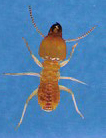Termites
Of some 300 or so species of termites only about 20 of these are of some economic importance in their region of occurrence. There are three main species of importance to NSW in particular to the Sydney region that we encounter most frequently.
Termites are mainly white or pale brown .Workers and soldiers are blind, sexless and wingless and have very thin cuticles that deteriorate when exposed to dry conditions or the open air. Termites live in colonies. Their nests are often found in living trees, in tree or ground mounds and even in subfloors. Not limited to these.
The reproductive forms have two pairs of equal wings are often seen swarming in the summer months, generally at sunset on a humid day.
Coptotermes Acinaciformis

A subterranean termite with the largest of colony sizes. It is the most destructive. It does not build mounds. It nests in living trees, in tree stumps, under patios, in subfloors and even in walls of houses.
A nest in a tree can contain up to 1 million termites in a single colony. Houses of up to a 100m radius of this tree can be attacked. They prefer damp conditions so ensuring that your property is free from water leaks and your subfloor is dry is a start to preventing them from eating your greatest asset. The nest contains a single queen, a king, eggs and nymphs. The soldiers and workers are out protecting their colony and munching on wood. The soldiers produce a white latex substance as a defence mechanism against predators. They generally mud pack in and around timber damage and their workings are often encountered by us appearing fluted in areas of active feeding.
Schedorhinotermes Intermedius
 This species is the second most destructive that we encounter. The nest may consist of many thousands of individuals. They have two types of soldiers unlike Coptotermes. When only minor soldiers are found, the colony can be very new or weak. The appearance of Major soldiers indicates a very strong and developed colony. These do not produce any latex substance as do Coptotermes.
This species is the second most destructive that we encounter. The nest may consist of many thousands of individuals. They have two types of soldiers unlike Coptotermes. When only minor soldiers are found, the colony can be very new or weak. The appearance of Major soldiers indicates a very strong and developed colony. These do not produce any latex substance as do Coptotermes.
They also like to nest in trees, tree stumps and homes and can cause significant damage.
Nasutitermes Walkeri
This species have mound or arboreal type nests and are often spotted in trees on coastal bushland or whilst driving in the country. They are very distinct as the soldiers have a pointed looking snout. Although structural damage is significantly less than the other two species, they can do a lot of surface damage to timber. Their workings are often found on the surface of trees and wood and seem to be very brittle to the touch.
When encountering termites, it is very important not to disturb them as they may shut down and resurface at another part of the house. Give us a call for some free advice. We are happy to talk to you about your problem with no obligation. Remember, termite damage is not covered by insurance.
